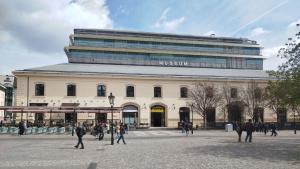
A new peak in total transaction volumes of €13.9 billion was reached last year across the CEE region. Including Austria and Serbia, the volume is even greater: €20.19 billion, according to CBRE’s latest research.
Most countries within CEE reached new investment milestones: Poland has the largest share (38%), followed by Austria (30%) and the Czech Republic (15%). Austria and Poland surpassed the €5 billion level, reaching €5.98 billion and €7.70 billion, respectively, while Romania, Hungary, and the Czech Republic all recorded volumes over €1 billion (€1.06, €1.72 and €2.98 billion at the end of 2019).
Once again, transactional activity was dominated by the office sector accounting for 44% of the total volume, followed at a considerable distance by the retail sector with 20% and industrial with 14%. Hotels, residential, mixed-use projects and multi-use portfolios represented a combined 22%. Over half of the total volume, 59%, was transacted in the capital cities.
The main source of capital over the last six years was from Western Europe with an average share of 35%, followed by local investors with a share of 28%. Investors from other overseas destinations, including China, Russia, Australia and Canada, have deployed €14.27 billion since 2014, representing a share of 16%. American investors claimed 11% of the total volume, followed by South Africans, investors from CEE Countries, and Israeli investors with a combined share of 10%, according to the latest Real Estate Investment Market Outlook 2020 report on extended CEE region launched by CBRE this month.
"It's the fourth year of growth in a row, with a new record transaction volume for the CEE core countries and excellent performance for the extended region. In 2020 we expect to see continued interest from investors for products across CEE markets, that will require a higher level of advisory and business acumen. CBRE expects COVID-19 is likely to have a negative short-term impact on certain sectors of the commercial real estate market in Europe, provided the outbreak is brought under control in a reasonable timeframe,” commented Anthony Selman, Head of Investment Properties CEE at CBRE.
After a strong year in the investment market, marked by continued appetite from local investors, Romania still has the highest prime office yield of the region, 7%, remaining attractive for local and international capital. With 74% of the total volume, the Romanian office sector dominates transactional activity, followed by retail with 16%, while industrial, hotels and mixed-use projects claimed a combined share of 10%.
"Romania is the only main CEE market, which has not seen significant yield compression. Since 2014, prime office yields have remained stable as have prime rents resulting in capital values that are now much lower than elsewhere offering investors great value for money," stated Gijs Klomp, Head of Investment Properties, CBRE Romania

Gijs Klomp
Head of Investment Properties Romania
CBRE
In 2019, Israeli investors were the most dominant with a record deal signed towards the year-end, representing 36% of the total investment volume. Romanian investors were the second most active representing 23% of total volumes and more active than the previous year, followed by South-Africans with a share of 17%. Regional cities remained appealing to market players, almost doubling their contribution to the total investment volume comparing with 2018.
"Although the beginning of 2020 raises some concerns, we should still see a steady growth of investment volumes backed by strong growth in investor demand. Yield compression is expected to continue in the short run on the back of continuously low-interest rates (with the risk of stifled economic growth, central banks are likely to keep rates low in this environment) and some degree of convergence with other CEE markets notably Hungary. To put into the context, over the last 14 years, the first quarter accounted for 20% of total annual investment per year, compared to the fourth quarter’s 30%. Moreover, given that the investment market moves slowly in terms of transactions, any effect on investment may not be observable immediately. The current market turmoil is likely to add additional downward pressure on already low interest rates, which will further strengthen the case for real estate as an investment class. Therefore, we will likely continue to see high demand for investment property even if there may be practical implications for transactional activity in the near future," explained Gijs Klomp, Head of Investment Properties, CBRE Romania



